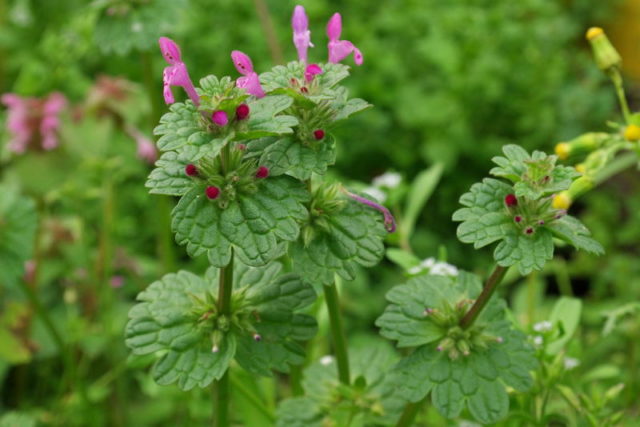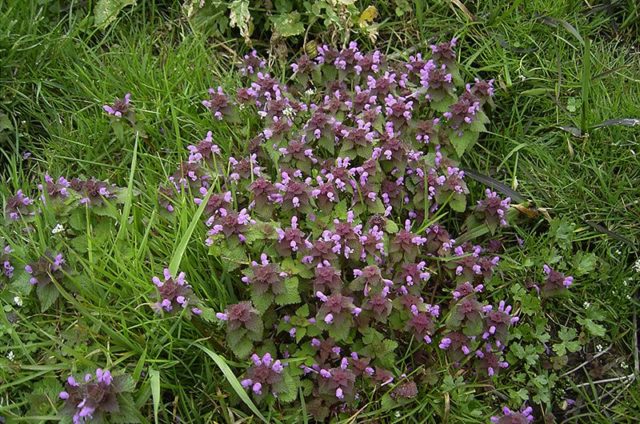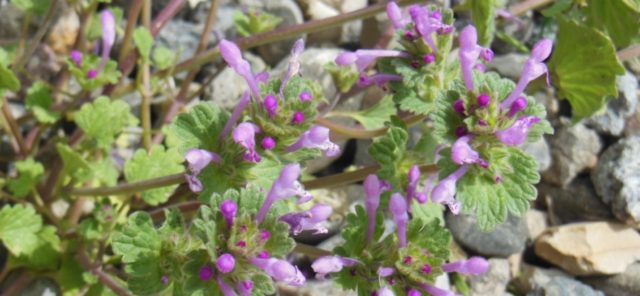Content
Stem-embracing lamb is a plant full of contradictions. On the one hand, it is a weed that reduces the yield of grain and vegetable crops. On the other hand, it is a raw material for the preparation of natural medicines. In addition, the stalky lamb is used in landscape design as a ground cover plant with a pleasant honey aroma.
Description and characteristics
Lamb lamb (Lamium amplexicaule) is an annual or biennial herb that belongs to the Lipoceae family. It is easily recognized by its rounded-kidney-shaped leaves with serrated edges and miniature buds collected in their axils. The photo shows the unusual shape of the pink flowers of the lamb: the tubular corolla ends with two lips, the lower one being longer than the upper one.

Lamb lamb prefers nutritious and well-moisturized soil
The tetrahedral pubescent stems of the plant extend from a single base and reach a length of 40 cm. At the same time, the height of the green cover of the cephalic beetle rarely exceeds 30 cm. The branched taproot extending deep into the ground provides its extraordinary vitality.
The most active of the stalk-embracing grass grows on light and fertile soils that do not experience a moisture deficit. A warm climate is ideal for her. In areas without winter cold snaps, the plant can bloom all year round. In the middle lane, this process lasts from mid-spring to late summer.
Each flower leaves behind a triangular nutlet about 2 mm in size. The stalk embracing breeds very quickly, since each specimen gives an average of 200 seeds. They germinate easily at a depth not exceeding 2 cm. For this, they need temperatures above 20 ° C. If the ground becomes colder (15 ° C), the germination of the seeds of the lamb will be impossible. Sprouts that appear in the fall are able to overwinter.
Where grows
Today, the stalk embracing cane can be found almost everywhere. Is that the northern part of Siberia and Africa turned out to be unsuitable for its growth. Most of all, she prefers forest and forest-steppe zones. The plant can often be seen growing in meadows, forest edges, along roads and near buildings. In fields and vegetable gardens, it usually acts as a weed that interferes with the normal development of crops.
Stem-embracing lamb, as can be seen in the photo, is not a particularly attractive plant in appearance. However, it is sometimes used to create a living carpet on the site. To a greater extent, gardeners are attracted by the honey smell and the beneficial properties of lamb.

Lamb lamb is not highly decorative, but is known for its honey aroma
Useful properties and application
In the past, the Slavs used various types of lamb for food. It contains a large dose of vitamin C and carotene. It tastes like spinach, so it can easily become a component of salads. This is especially useful in the spring, when the body is acutely deficient in vitamins.
In the process of studying the cephalic beetle, the following valuable components were found in its composition:
- Tannins - eliminate inflammation of the skin and have an astringent effect.
- Plant mucus - produces an expectorant effect.
- Flavonoids - provide a hypotensive effect and strengthen the walls of blood vessels.
In some countries, lamb has found its use as a component of healing ointments. It is also added to dietary supplements designed to strengthen the body. Today the positive and negative properties of the plant are under investigation. It is known for sure that it does not contain poisonous compounds.
In folk medicine, it is used for such problems:
- bronchitis;
- cold;
- angina;
- jaundice;
- malaria;
- asthma;
- hemorrhoids;
- neurosis;
- damage to the skin and mucous membranes;
- inflammation of the urinary system.
Stem-embracing lamb has several contraindications. People suffering from chronic hypotension and increased blood clotting should never use it for treatment. The same applies to pregnant women.
Treatment methods
In folk medicine, there are several ways to use the stem-embracing lamb:
- Tea. For its preparation, plant flowers are used, since most of the nutrients are concentrated in them. A cup of healing tea is prepared from a spoon of the plant. It is recommended to drink no more than 3 times a day to saturate the body with vitamins. A mug of such tea drunk at night helps to fall asleep. It is good to mix with yarrow flowers.
- Broth. A spoonful of flowers and leaves is poured into 200 ml of boiling water and placed in a water bath for a quarter of an hour. Take half a glass 3 times a day for severe cough, sore throat or colds.
- Alcohol tincture. A spoonful of dried plant flowers is poured with 300 ml of vodka. Insist 7 days, shaking regularly. The recommended dose is 30 drops for 3 approaches per day. Helps with inflammation of the genitourinary system.
- Bath. A spoonful of dried flowers with leaves are poured into 1.5 liters of boiling water and insisted in a thermos for about 30 minutes. After that, the infusion is poured into the bath. With a daily procedure, improvements in the condition of the skin occur within a week.
What crops can clog
Lamb's lamb infests both grain and row crops. She often causes problems for gardeners and gardeners. It creates significant damage to yield only when it is massively distributed.

Lamb can be a weed, ornamental and medicinal plant
The fight against it is carried out by mowing before seeding. For sowing of winter crops, spring harrowing is carried out for protective purposes. Soil herbicides show good efficiency.
Conclusion
Lamb lamb is a weed that can be used with health benefits. The plant is unpretentious, therefore, leaving it on the site, you can safely count on getting high-quality raw materials for the preparation of a medicinal decoction or infusion. The main thing is to prevent its uncontrolled reproduction in the garden or among garden crops.








